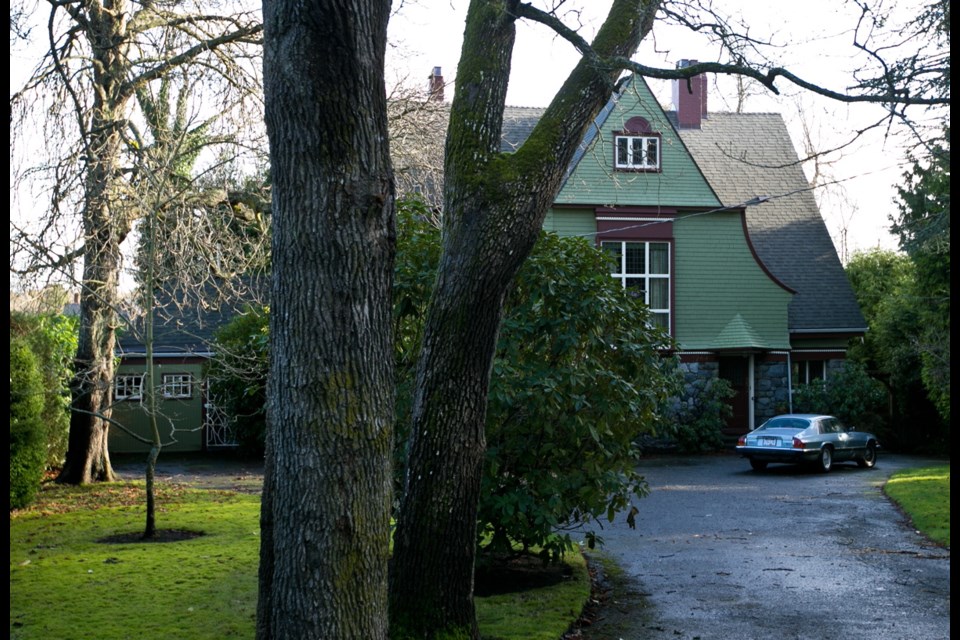Picking the 10 Best Heritage Houses in our region was a daunting task. There are simply so many gems, so how does one choose a specific list?
Will it be based on homes of the rich and famous or the grand mansions of past generations?
The Hallmark Heritage Society, the oldest heritage preservation group in the Capital Regional District, chose another path. Its board members based their list on the homes of “those who laboured long and without recognition to leave us with a rich legacy of vernacular buildings.”
Their eclectic mix includes rustic, hand-hewn cottages, familiar traditional styles and modern designs reflecting a West Coast design theme.
“Each one is a home, a place where families were forged over the course of time and where each house is an integral part of a neighbourhood,” said Hallmark president Ken Johnson. “Family and neighbourhood are the most important values to be found in any established neighbourhood with its rich mosaic of house ages and styles.”
(Descriptions of homes were provided by Hallmark Heritage Society.)
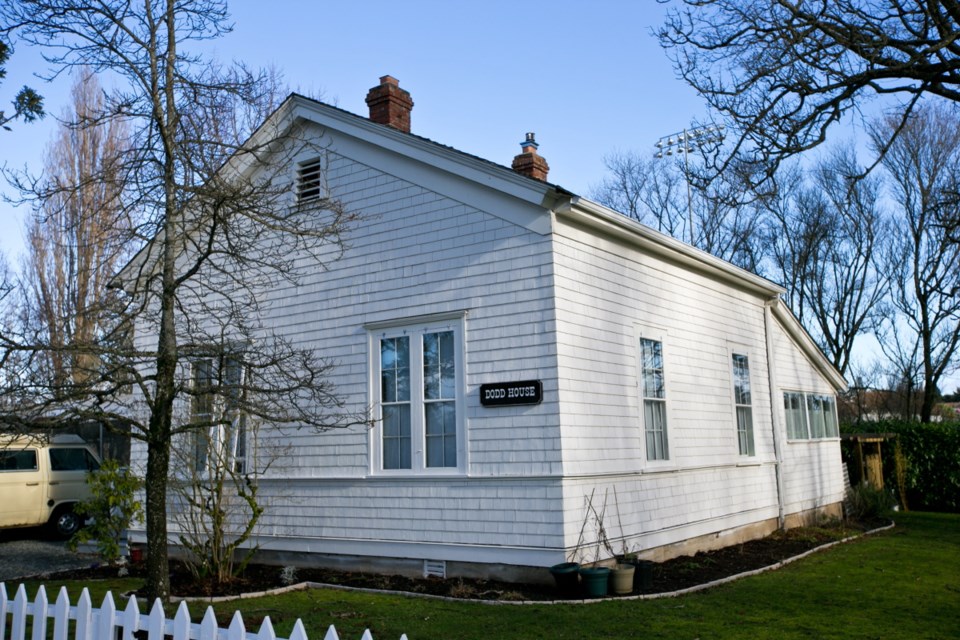
Dodd House, 4139 Lambrick Way, Saanich, Built 1859
The oldest house still standing in Saanich and one of the oldest in Greater Victoria, Dodd House was built on 276 acres in Gordon Head for Captain Charles Dodd and Grace Dodd (McTavish), as a country home. Dodd House is a simple frontier cottage, clad in shingles, with a sitting room, two bedrooms and a lean-to kitchen. The tall, double-hung windows are arranged in pairs. The interior, with its 12-foot ceilings, is lined in redwood tongue-and-groove boards with decorative mouldings of a quality that could not be obtained on Vancouver Island at the time of construction. The redwood was imported from California, an indication of the dominant trading pattern of the Island prior to the arrival of the Canadian Pacific Railway on the coast in the 1880s as well as Dodd’s ability to acquire high quality materials using professional relationships. Dodd House is also valued as the earliest known house on the Island to have been constructed using balloon framing techniques, rather than the Hudson Bay Company’s method of adzed-log-wall construction.
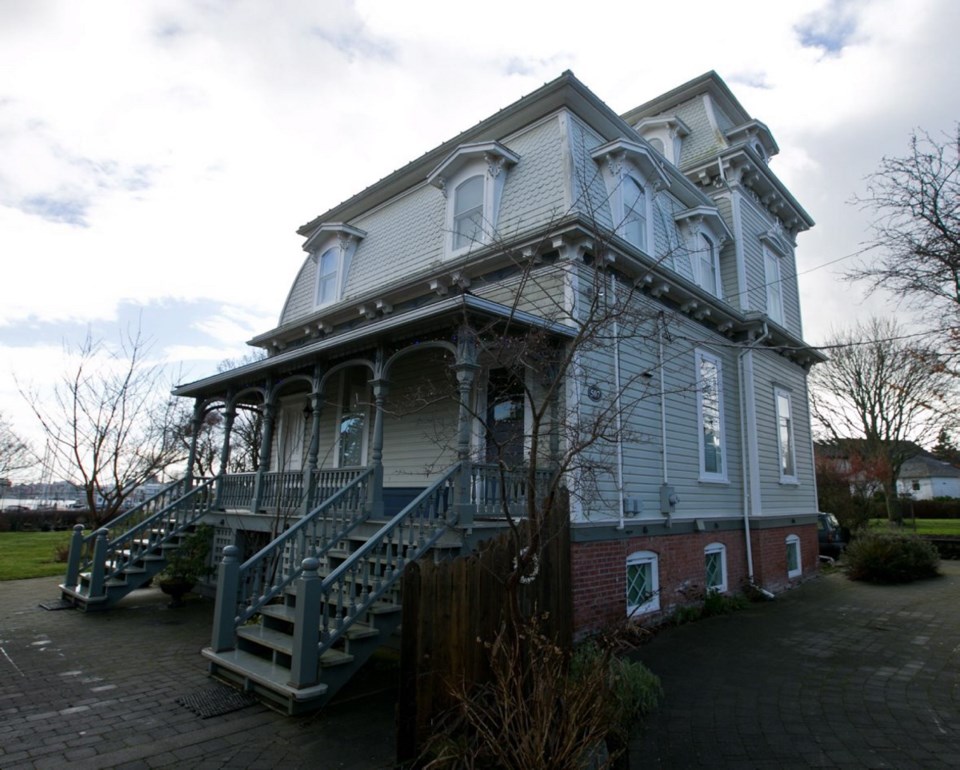
Captain Jacobson’s House, 507 Head St., Esquimalt, Built 1893
The home was built in the Steamboat Gothic style and is oriented four-square to the compass. The square, three-storey tower with a convex mansard-type roofline and hooded dormer windows provides a good view of West Bay and the sealing fleet. The exterior is covered with bargeboard siding accentuated with hearts, butterflies, birds and anchors apparently carved in wood by the captain. The front entranceway features decorative posts with spindles while the southern exposure boasts a complex bay window. The original owner, Captain Victor Jacobson, was born in Finland in 1859 of Swedish parents and sailed the world as a young man. He came to Victoria in 1880 where he became involved in the sealing industry. By the time he built the house, he was well established as a skipper of several vessels, some of which were anchored just outside his back door. He is also known for working on the restoration of the Tilikum, an Indian canoe that had been piloted by Captain J. C Voss on his famous voyage from Victoria to England in 1901-1904. At the time of this work, he was more than 80 years old.
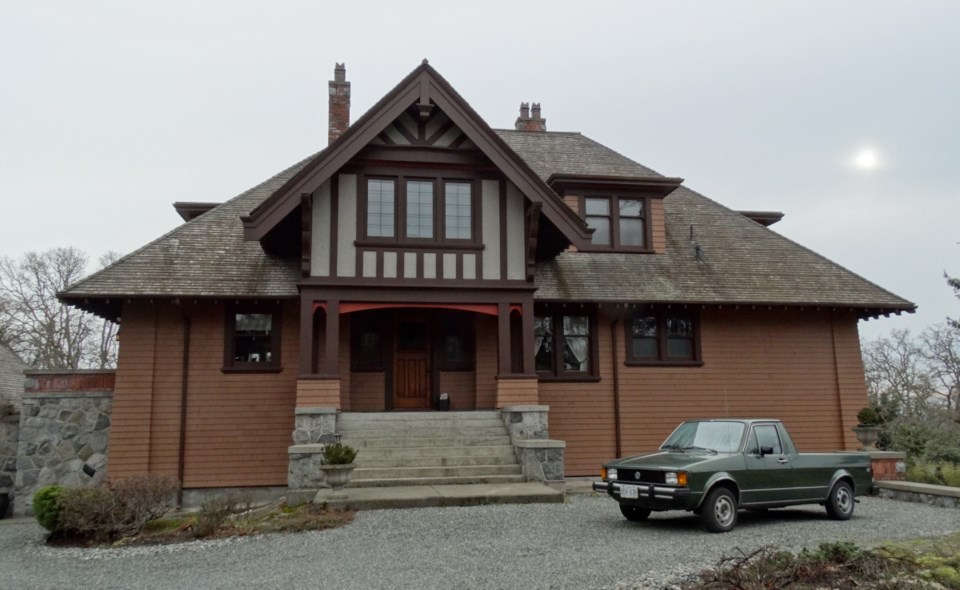
Jones Residence
1911 Woodley, Saanich
Built 1913
Designed by architect Samuel Maclure, this one-and-one-half-storey bungalow was built in the British arts and crafts style. The main floor walls, shed-roofed dormers and front-porch balustrade are clad with brown cedar shingles. The upper level of the front porch is half-timbered and has heavy beams, bargeboards, brackets and a drop finial. Windows are a mixture of multi-paned double-hung and casement, leaded and stained glass wooden-sash. Many interior features, including wood floors and wooden-trim and detailing, date from the original construction.
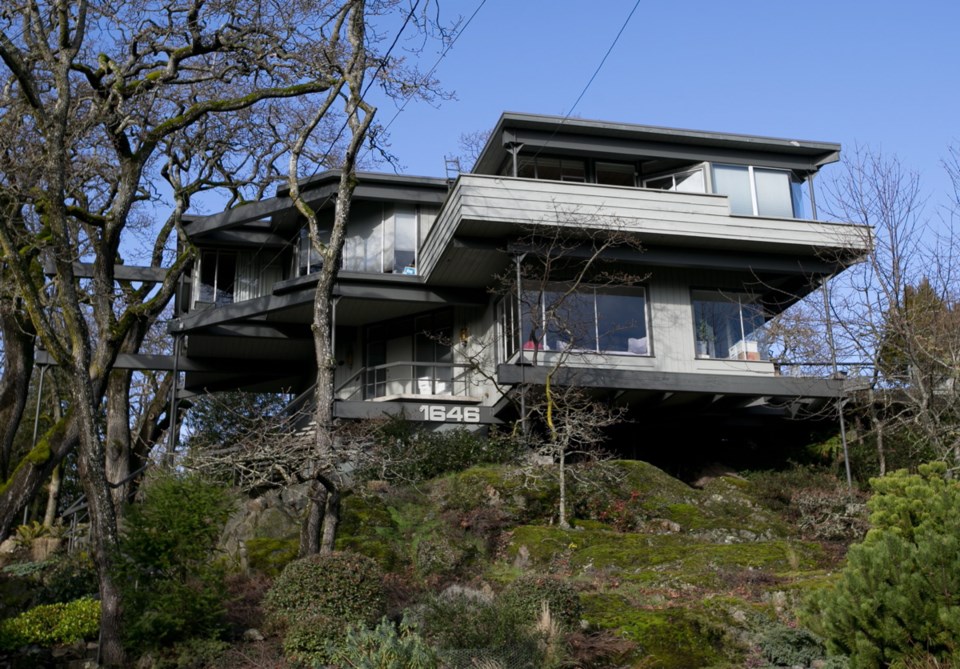
Thomson House
1646 St Francis Wood, Victoria
Built 1957
Although a number of very interesting modern houses are evident throughout Greater Victoria, the City of Victoria proper, largely built up by the 1940s, has only a handful of distinctive post-war houses. These are all the more valuable for their rarity. Sited on a rocky knoll at the end of St Francis Wood at the east end of Rockland, this home designed by architect John de Castri is arguably one of the finest post-and-beam, West Coast-style houses in the area, and is of interest for students of regional architectural design. Built in 1957, the Thomson House presents an innovative display of structural expression. A reinforced concrete foundation core is anchored to the rock, while a heavy glue-lam beam system projects out forcefully from the house, with the thrusting outer spans of the beams supported on steel pipe columns. The floor and roof decks are fashioned from a tongue-and-groove system. The form of this unique structure is arrayed in a spiraling asymmetry, with dramatic overhangs of beams and decks. Windows are large panels of plate glass with mitered corners, which act to emphasize the free-form, floating appearance. Set into a grove of mature Garry Oak trees, the house itself is a kind of abstract architectonic tree.
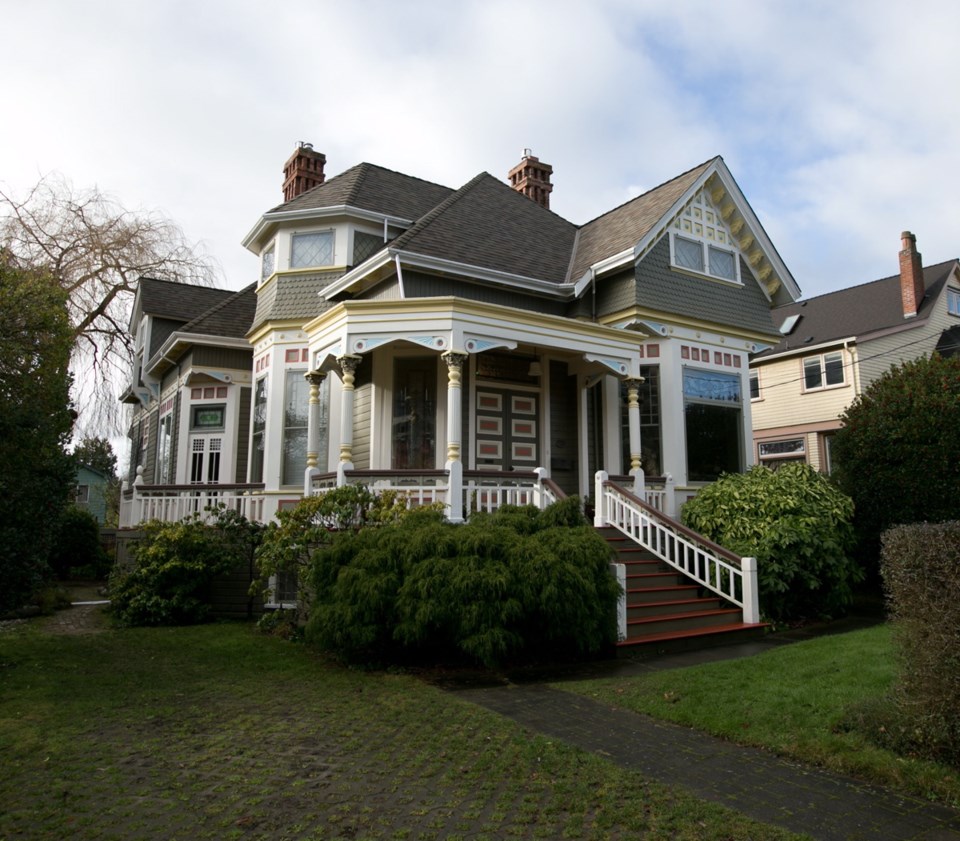
Spring Cottage
301 Kingston St., Victoria
Built 1892
Designed by architect Thomas Hooper for Capt. Charles Spring, the Spring Cottage is an elaborate one-storey Victorian Queen Anne-style house with a complex hipped roof and many dormers. The eaves are profusely bracketed. It was built at a cost of $5,300. The unfortunate use of cedar shakes makes for a rustic texture at odds with the fine millwork. Drop siding is used for most of the walls below a frieze of vertical V-joints. There are many elaborate sashes with leaded art glass transoms. The verandah with turned and reeded columns and Corinthian capitals wraps around the corner next to an angled bay with projecting gabled roof decorated with fish-scale shingles and bosses. The left side has a two-storey angled bay, and the right a box bay. A corner door provides access to a side porch. Two fine chimneys would benefit from rebuilt corbels.
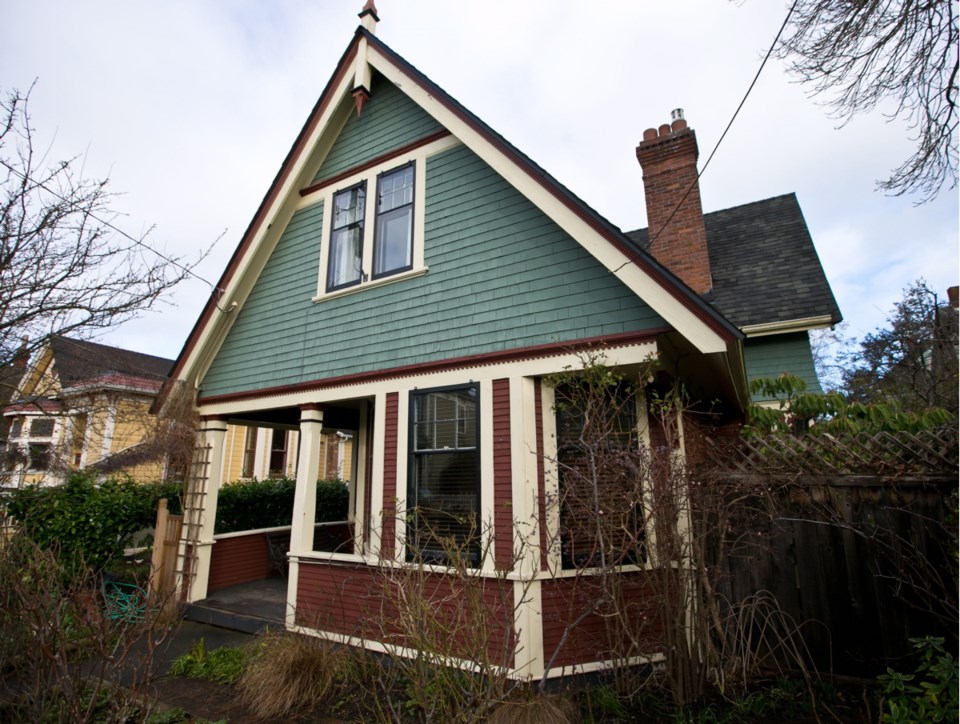
F. Widdowson House
624 Avalon St., Victoria
Built 1904
It has been suggested that some of architect Samuel Maclure’s houses provided the model for the ubiquitous Edwardian Vernacular Arts & Crafts house design, thousands of which were built in the Victoria area between 1904 and 1914. This house, similar to one that he planned in 1900 at 1807 Oak Bay Ave. (since demolished), certainly gives credence to that claim. It is a narrower version of his grander chalet-style house at 1598 Rockland Ave., built in the same year. This is a characteristic one-storey, front-gabled Edwardian Vernacular house with a steeply-pitched roof. Unusually it has a gabled wing on the right side with a cutaway angled bay. On the left is a through-the-roof wall dormer with offset windows. The symmetrical front gable is separated from the asymmetrical main floor by a dentilated belt course. The main floor consists of a cutaway angled bay to the right of a recessed entry porch. The porch has three square chamfered posts and a closed balustrade. Most of the windows are six-over-one double-hung sashes. The gables are shingled and the main floor is clad in double-bevelled siding. There are two corbelled brick chimneys.
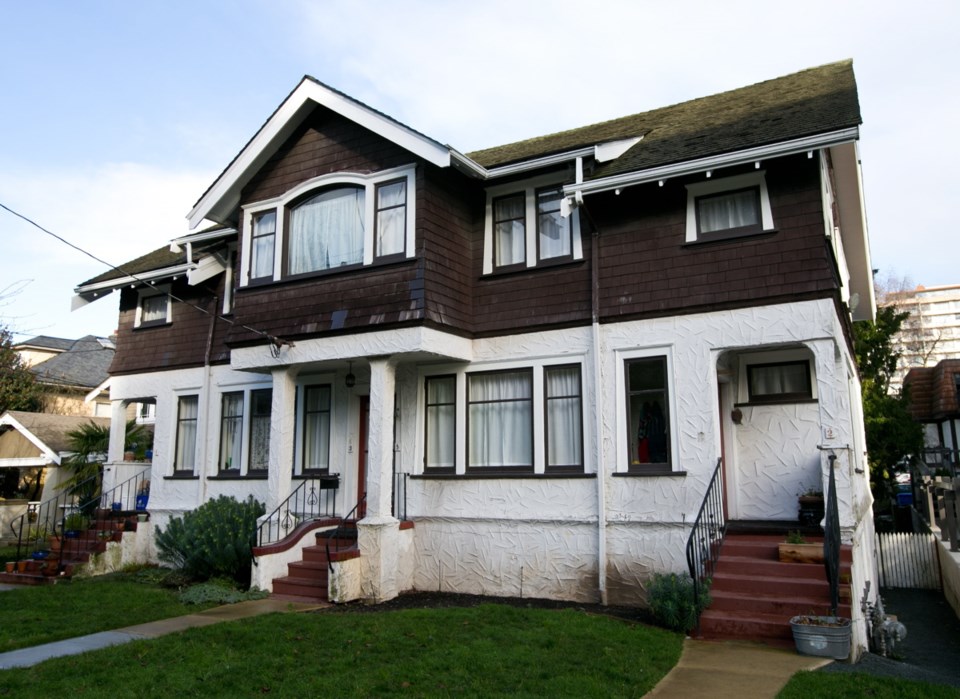
House of All Sorts
642 Simcoe St., Victoria
Built 1913
Emily Carr’s Hill House, now known as House of All Sorts, was designed by John Wilson as two rental apartments on the main floor and her home and studio upstairs. This large British arts and crafts style two-storey, side-gabled house has later rustic stucco on the main floor below the shingled upper floor. Originally, it was all shingled. The symmetrical front façade has a prominent box bay with gabled dormer roof. The bay is supported on two heavy posts with small brackets that frame the middle door and echo the side doors at each corner, which are sheltered by recessed corner porches. Window trim has angled sides giving an Egyptian revival flavour. Featured in the upper box bay is a three panelled window with an arched central sash. The central dormer of the main façade is given extra ceiling height by a low shed dormer roof on either side. The rear has a second-floor recessed sleeping porch and a shed roof. The overall effect is a profusion of windows, perhaps reflecting an artist’s concern for light.
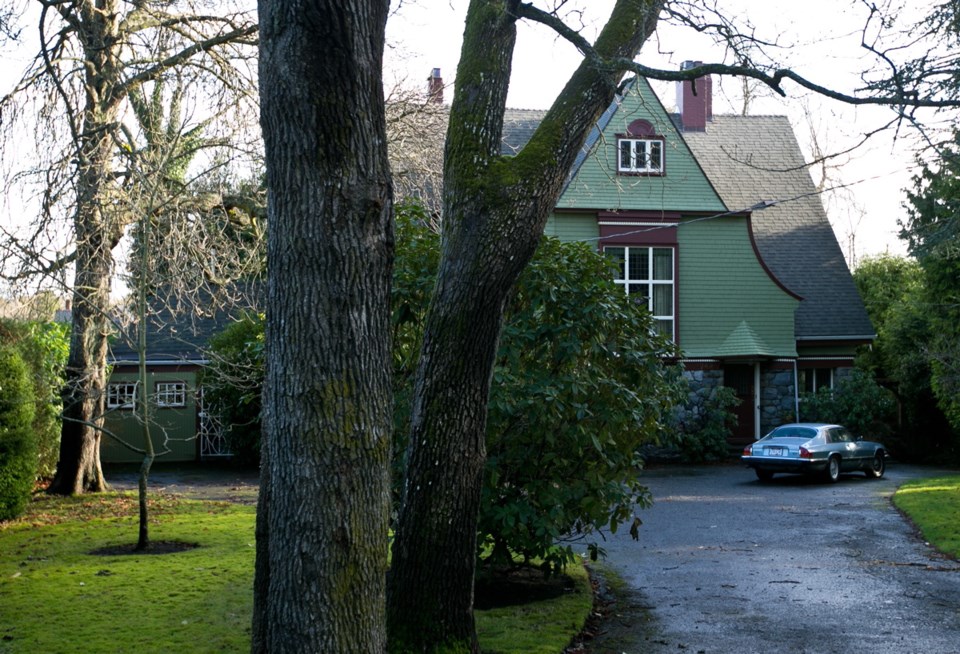
Ashton
1745 Rockland Ave., Victoria
Built 1899
Designed by architect Francis Mawson Rattenbury, this two-storey house is one of Victoria’s best examples of the Shingle Style, a mixture of American and British arts and craft influences. It has a steeply-pitched, side-gabled roof with a prominent, front-facing pedimented gable over a nine-light leaded and mullioned window bay; a small vent in the gable has been replaced by a bank of three narrow windows under the original semicircular motif. To the left of the bay is a parapet or decorative balcony immediately above a bank of three small windows. To the left of the parapet is a smaller pedimented gable above two windows. There is a complete absence of visible eaves, rafters or bargeboards. A denticulated belt course separates the rustic stonework of the main floor from the shingles above. The body of the house originally had brown shingles, which blended with the roof in typical shingle style. The attached carriage house on the left has been enclosed and is now a garage. The curved roofline and the small pyramidal hood above the front door emphasizes the unusual triangular composition of this façade.
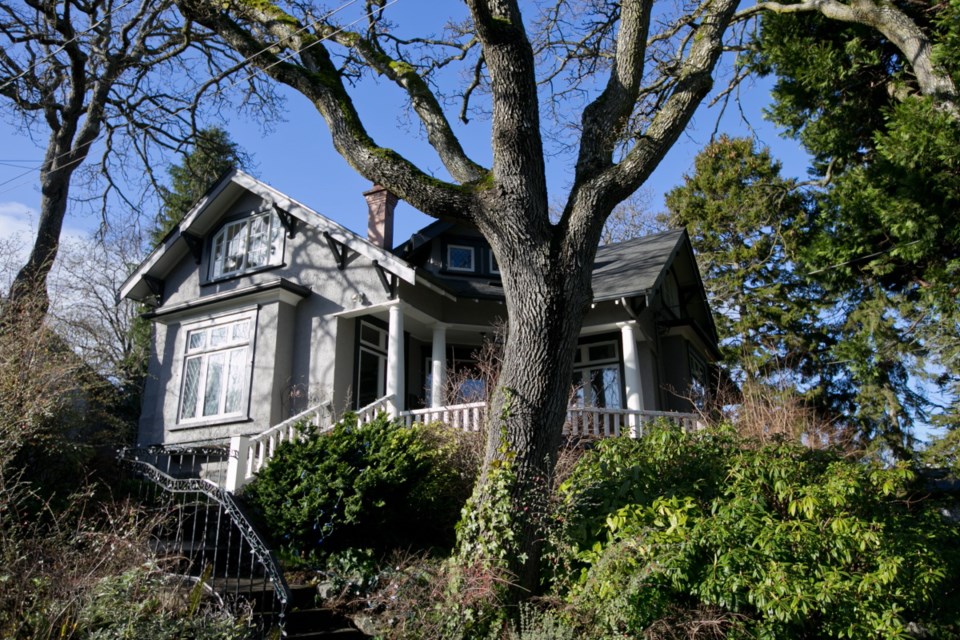
James Stewart Clark House
1086 St. Louis St., Oak Bay
Built 1912
This home is valued as a distinctive local landmark within its neighbourhood and a fine example of the work of architect David Cowper Frame. It is also a good example of how an architect develops a design. It is a variation and smaller version of an angled (butterfly plan) floor plan that Frame used at Kingsmont [305 Denison] in 1911. D.C. Frame primarily designed residences and this house, as well as Kingsmont, are two of his most inventive. The James Stewart Clark House is also significant as an example of how the use of typical design elements of the period — gabled brackets, Doric columns, leaded windows — can be combined in unusual ways to provide contrast to other more usual house designs of the period. The principal interiors of the house have many original features, including stained fir panelling, one tile and one brick fireplaces, window seats, beamed ceilings, brass wall sconces, leaded casement windows and upper-floor sleeping porches — all adapted to Frame’s unique angled floor plan. The garden retains two rock gardens in their original configuration.
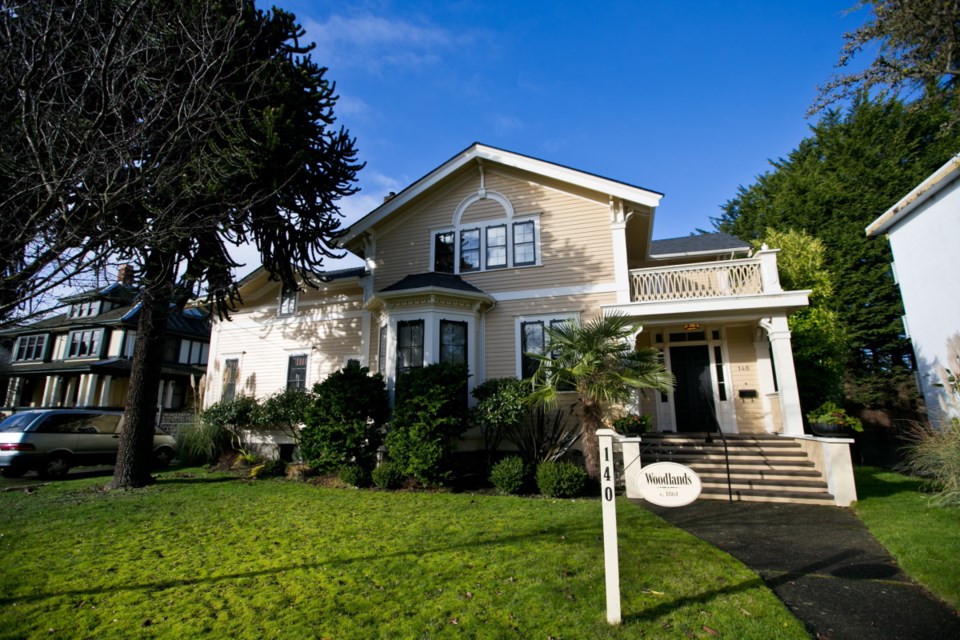
Woodlands
140 Government St., Victoria
Built 1860s
Designed in the Italianate Villa style by Wright & Sanders, this house was built of California redwood because the means to finish local lumber was not yet available in Victoria. The house originally faced Simcoe Street. It is a rare and valuable home, as one of the earliest architect-designed buildings in the city, and one of the few remaining structures by Wright & Sanders. The house now has a front-gabled roof with large side-gabled projections on both sides. However, the right side gable was originally the front façade. The present main façade is noteworthy for its angled bay with fretwork scrolls and scallops at the eaves. Medium-width bevel siding is used throughout and the scrollsawn trim is much more individual than later mass-produced gingerbread. The second storey has a row of four double-hung sashes with a blind arch above creating the effect of a Palladian window; several others are also arched. The recessed porch to the right has a severely elegant classical sidelight and transom arrangement. Balusters on both ground level and the balcony above have a slender lyre shaped fretwork design not part of the original 1909 alteration by Samuel Maclure. Corner pilasters all round are capped with pairs of fretwork scrolls. A back porch has a window opening with a fretwork screen. Chimneys are panelled with arches and corbelled. The foundation is a mix of semi-dressed stone. A monkey puzzle tree in front adds to the period flavour and illustrates the Edwardian delight in the exotic.
